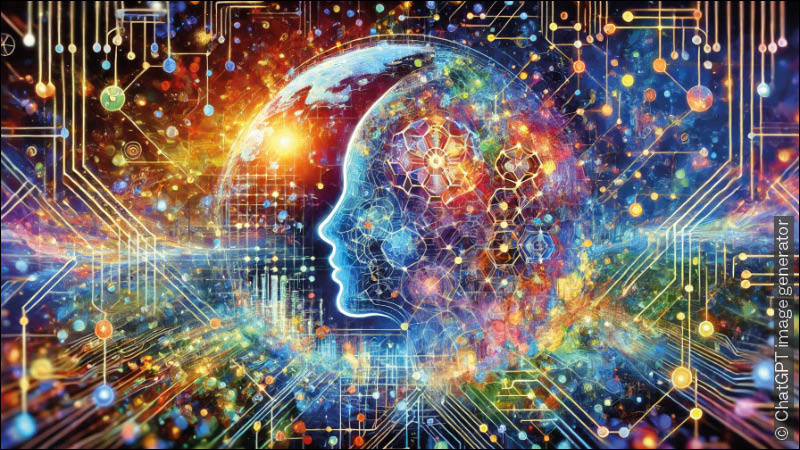A team of scientists led by Prof. Dr Ilka Diester, Professor of Optophysiology and spokesperson of the BrainLinks-BrainTools research centre at the University of Freiburg, has developed a formal description of internal world models and published it in the journal Neuron. The formalised view helps scientists to better understand the development and functioning of internal world models. It makes it possible to systematically compare world models of humans, animals and artificial intelligence (AI). This makes it clearer, for example, where AI still has deficits compared to human intelligence and how it could be further developed in the future. Eleven Freiburg researchers from four faculties were involved in the interdisciplinary publication.

Graphic: Generated with ChatGPT image generator
Internal world models: making predictions based on experience
Humans and animals abstract general laws from everyday experiences. They develop internal models of the world that help them to find their way in unfamiliar contexts. Based on the abstracted models, they can make predictions in new situations and behave accordingly. For example, knowing comparable cities that also have a city centre, pedestrian zones and public transport can help them find their way around a foreign city. Even in social contexts such as dinner in a restaurant, comparable experiences help you to behave appropriately.
World models become more tangible with the help of a new formal description
In order to formalise internal world models across species, the researchers distinguish in their current publication between three abstract spaces that are intertwined: the task space, the neural space and the conceptual space. The task space encompasses everything that an individual experiences. The neuronal space describes the various measurable states of the brain, from the molecular level to the activity of individual neurones through to the activity of entire brain areas. The latter is visualised with the help of a functional magnetic resonance imaging (fMRI) scanner, for example, or measured using techniques such as high-density electrodes or calcium imaging. The equivalent of neural space in AI is the activity of the nodes within the corresponding artificial neural network. The conceptual space consists of pairs of states of the task space and the neural space. These pairs thus represent the status of an individual, which links internal processes with external influences. The current state is constantly changing by transitioning to the next state with a certain probability. These combinations of an individual's experiences on the one hand and the corresponding brain activity on the other, as well as the dynamic transitions, make the individual internal world models scientifically tangible.
Eliminate deficits in internal world models
With the help of the formalised view scientists can now analyse internal world models across disciplinary boundaries and discuss how they arise and evolve. Findings from research on humans and animals, for example, should help to improve AI. For example, current AI systems are not yet able to check the plausibility of their predictions. Even large language models such as ChatGPT have so far only functioned as pattern recognition machines without the ability to actually plan. However, planning is important in order to play through and correct strategies in unknown situations before they are implemented and possibly cause damage. Researchers also suspect that deficits in internal world models could be the cause of some mental illnesses such as depression or schizophrenia. A deeper understanding of world models could help to use medication and therapy in a more targeted way.
- Original-Publication: Diester et al., Internal world models in humans, animals, and AI, Neuron (2024), https://doi.org/10.1016/j.neuron.2024.06.019
- Prof. Dr Ilka Diester is Professor of Optophysiology at the University of Freiburg and heads the Optophysiology Lab at the Faculty of Biology. Prof. Diester is also spokesperson of the BrainLinks-BrainTools//IMBIT research centre and the Brain and Intelligence research field at the University of Freiburg. Most of the study's co-authors are also researchers at the University of Freiburg: Prof. Dr Marlene Bartos is Professor of Cellular and Systemic Neurophysiology and spokesperson of the IN-CODE CRC; Prof. Dr Joschka Bödecker is Professor of Neurorobotics; Dr Adam Kortylewski is Emmy Noether Group Leader at the Department of Computer Science; Prof. Dr Christian Leibold is Professor of Theoretical Systems Neuroscience; Prof. Dr Johannes Letzkus is Heisenberg Professor at the Institute of Physiology; Prof. Dr Monika Schönauer is Junior Professor of Neuropsychology; Prof. Dr Andrew Straw is Professor of Neurobiology & Behaviour; Prof. Dr Abhinav Valada is Chair of Autonomous Intelligent Systems; Prof. Dr Andreas Vlachos is Professor of Neuroanatomy; Prof. Dr Thomas Brox is Professor of Pattern Recognition and Image Processing. Professors Bödecker, Valada and Brox are part of the European Network for Machine Learning and Intelligent Systems ELLIS. Dr Matthew Nour is a researcher at the University of Oxford in the Department of Psychiatry.
- The publication results from a workshop of the BrainWorlds initiative at the research centre BrainLinks-BrainTools//IMBIT at the University of Freiburg.






